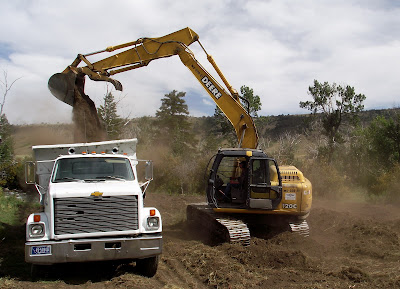One of the casualties of The Great Deluge of May 2011 -http://mellinniumcowboy.blogspot.com/2011/05/deluge.htm - was a section of the foundation of the old horsebarn.
The barn was built in 1918, and the walls are 18” thick. Ted and I had already repaired part of the wall, jacking it up and pouring concrete to support it. We had started working on this next section last fall, and were stopped by rain and snow.
The extreme precipitation of this spring softened the ground under our jacks, and the wall caved in. We finally got time to work on it now in August. The first step was to dig the rocks out and pile them out of the way, then push the concrete rubble out away and dig out the trench to pour a new footer.
As we worked, I thought about the process of building this barn ninety years ago. The stones were all picked by hand and pulled by horses to the site on a stoneboat. The concrete was likely shipped in to Big Timber by rail, then hauled out in a wagon. Everything was done by sheer muscle-power.
We enjoyed the benefit of a tractor and front end loader. We could roll the stones in until we had a load, then simply put the tractor in gear, drive it to where we would pile them, and move a lever to dump the load. We could likewise scoop up the remaining ruble and place it where it will be a help rather than a hindrance.
Soon after we got the wall cleaned up, a truck arrived with an excavator to dig up material we will need to fill in the huge ruts left in the road by that same spring storm.
In the old days they used a fresno to move dirt. This implement resembles a wheelbarrow without the wheel. Pulled by a team of horses, the driver walks behind, raising the handles to dig the leading edge into the dirt, lowering the handles to let the load drag along, then lifting the handles up and over to tip the load where it is needed.
The dirt must first be loosened with another team and plow. It took a lot of muscle-power on the part of both man and beast. Hauling for any distance would have required an overpass structure to get the team and fresno up over a wagon to dump.
This excavator, however, takes almost no physical effort. The operator sits in a comfortable seat in an air-conditioned cab. Both hands and feet are on hydraulic controls that respond quickly and easily to the lightest of touch. It picks up tons of material in minutes and drops it into the truck, which hauls more in one load than a team could move in a day, and tips the box up at the touch of a lever to leave the material in a pile or spread it wherever it is needed.
Ted’s demeanor at the controls of that excavator is the same as his demeanor atop a horse. He is totally relaxed, yet both the horse and the machine are equally responsive to his every movement, reading his intentions and magnifying them to accomplish the task – the machine vastly increasing the power of his arms, and the horse giving him speed and agility he could never accomplish afoot.
William Elges, who homesteaded this ranch in 1896, could never have imagined a time when every ranch would have hydraulically-operated equipment to cut, bale, stack, and feed the hay, to dig, and to haul, and to lift – but I’ll bet he would have been quick to use it!
The casualty of this move toward mechanization, however, is millions of jobs in agriculture. Rather than a huge workforce of unskilled labor, ranching now requires many fewer workers, but with much higher skill levels. And it is much harder for a person with no experience to find a job on a ranch.



Hi there. Nice blog. You have shared useful information. Keep up the good work! This blog is really interesting and gives good details. hydraulic cylinder manufacturer in Delhi, hydro cylinder supplier Delhi.
ReplyDelete